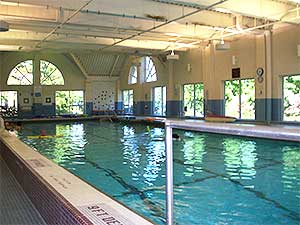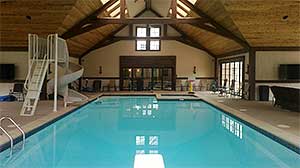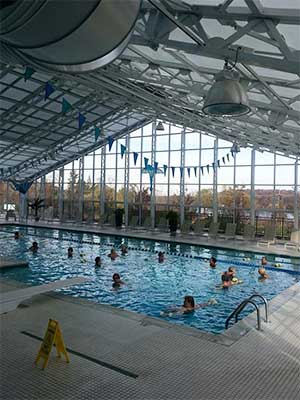 Indoor pools are notoriously prone to air quality issues. Most notably, the infamous “chlorine smell” noticed as soon as you enter the pool room. The first and most common method used to address this problem involves diluting the air with fresh air from outside of the contaminated area. In some cases, attempts are made to install a return air vent at deck level to draw off the offending air particles.
Indoor pools are notoriously prone to air quality issues. Most notably, the infamous “chlorine smell” noticed as soon as you enter the pool room. The first and most common method used to address this problem involves diluting the air with fresh air from outside of the contaminated area. In some cases, attempts are made to install a return air vent at deck level to draw off the offending air particles.
Neither of these solutions actually addresses the root of the problem. Why does it exist at all? How can it be properly addressed with the least cost? These intriguing questions, when answered sufficiently, can reverse one of the most frustrating and unnecessary pool complaints.
We all know the signs posted in locker rooms of both indoor and outdoor pools advise swimmers to shower before entering the pool. Most pool users are unaware that this shower is more than a call to rinse obvious debris from the body. We know the more pertinent goal is to remove the chemical debris accumulated in various ways throughout the day: Lotions, oils, sweat, urine, and natural body chemistry react with the chemicals used to treat the pool water.
The mixing of the various chemical components produces two specific reactions. Both reactions create significant health hazards for swimmers. The first by-product is called chloramines. This “sticky”, “heavy” substance generally lays on the surface, the top 4-10 inches of the pool water. It is difficult to remove and contaminates everything it touches.
 The second by-product is the unforgettable smell of the pool area. This is the out-gassing from the chemical reaction taking place between the pool chemicals and the foreign chemicals being added. The solution of bringing more fresh air in from the outside of the building hosts it own set of problems. Primarily, it does not address the root of the problem. It therefore becomes a costly “band-aid” to the situation at best.
The second by-product is the unforgettable smell of the pool area. This is the out-gassing from the chemical reaction taking place between the pool chemicals and the foreign chemicals being added. The solution of bringing more fresh air in from the outside of the building hosts it own set of problems. Primarily, it does not address the root of the problem. It therefore becomes a costly “band-aid” to the situation at best.
Increasing the flow of exterior air increases operating costs. Particularly, these costs escalate depending on the regional climate involved. The air of cold climates must be warmed before entering the pool environment. The hot, humid air of warmer seasons or climates is essentially untreatable. Pool dehumidification systems may potentially need to be upsized to handle the additional load. Attempting to condition both exterior and interior air is a costly and ineffective solution to the problem of pool smell.
 The concept of placing an air return duct at the deck level may hosts its own set of side effects. Hot, humid air rises. Its accumulation (stratification) at the ceiling level leaves the higher likelihood of moisture migrating into the ceiling areas. This could cause water damage, mold and mildew growth, rot, corrosion, and structural damage. A deck level (return air) is incapable of dealing with this situation. It may also interfere with the relative humidly in the room. Overall, this is an inefficient and pricey answer to a problem that is left unresolved.
The concept of placing an air return duct at the deck level may hosts its own set of side effects. Hot, humid air rises. Its accumulation (stratification) at the ceiling level leaves the higher likelihood of moisture migrating into the ceiling areas. This could cause water damage, mold and mildew growth, rot, corrosion, and structural damage. A deck level (return air) is incapable of dealing with this situation. It may also interfere with the relative humidly in the room. Overall, this is an inefficient and pricey answer to a problem that is left unresolved.
To summarize, the pool dehumidification system did not create, nor can it resolve, the problem of chloramines and poor pool chemistry with the subsequent pool smell. A well designed and maintained air delivery system deals with the humidity of the pool area and the problems created by undue humidity in the environment.
It may potentially aid the air turnover rates but it cannot prevent the chemical reaction and accumulation of chloramines. The better answer is to educate swimmers of the necessity of showering prior to pool entry and to train/educate the staff maintaining the pool to control these reactions by maintaining the proper chemical balance.
